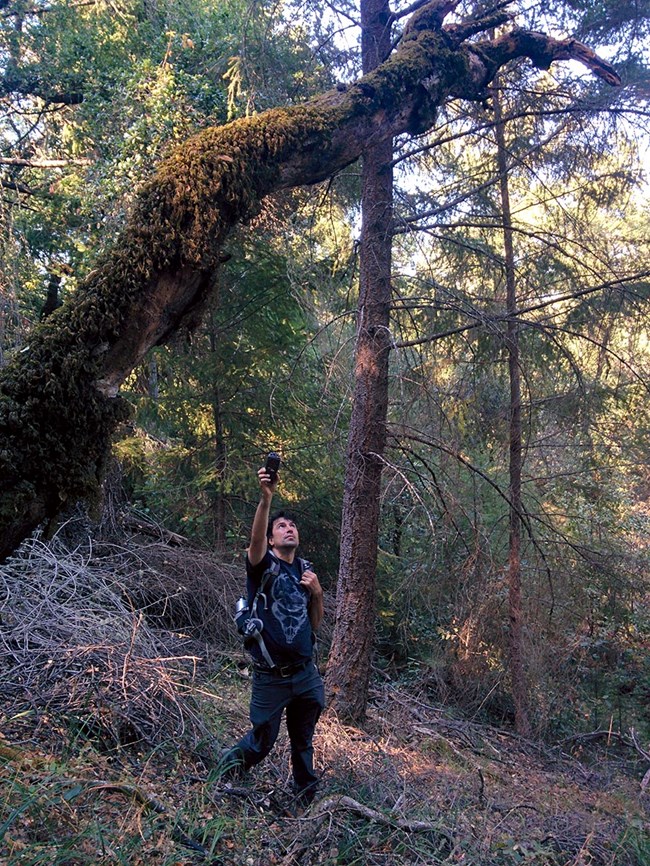Last updated: October 26, 2021
Article
Bat Conservation in the San Francisco Bay Area

Katie Smith / Golden Gate National Parks Conservancy
What is the NPS doing about bat conservation and preventing the spread of White nose syndrome in the San Francisco Bay Area region?
Although deadly fungal disease White Nose Syndrome has not yet spread to the San Francisco Bay Area, researchers are making efforts to better understand local bat populations so they can guard against potential threats. With seven of the county’s 13 bat species believed to be of special concern, we need to know more about these important creatures. Park scientists, in collaboration with partners at USGS and One Tam, have been monitoring bats in Marin County (Point Reyes, Golden Gate) and Pinnacles National Park since 2017. They use various techniques, including radio telemetry and acoustic detectors.
The current biggest threats to Bay Area bats are habitat loss and disturbances to the places where they roost, so researchers are hoping to learn more about bat roosting habits and how they use local habitats. In addition, this information could help us understand how susceptible bats are to White Nose Syndrome in the event that the fungus spreads to the Bay Area.
Acoustic Monitoring
In the San Francisco Bay Area, Pinnacles National Park, Point Reyes National Seashore, and Golden Gate National Recreation Area conduct summer acoustic monitoring. Monitoring at Point Reyes and Golden Gate is part of the wider multi-agency Marin Bat Monitoring Project on Mt. Tam. Researchers set up acoustic detectors across the study area based on protocols from NABat, a multi-agency monitoring effort for bats across North America. Recordings from the detectors are then analyzed to identify the calls of different bat species. This provides researchers with a better understanding of the the presence and activity of various species on the landscape.

Golden Gate National Parks Conservancy / Katie Smith
Mist Netting and Radio Telemetry
Acoustic monitoring is not always a comprehensive way to detect all species, particularly those that have quiet calls like the Townsend's big-eared bat. So in addition, parks do mist netting and radio telemetry in summer and winter. They capture bats using mist-netting, attach a temporary radio telemetry transmitter to the bat (which always weigh less than 5% the bat's bodyweight and will fall off after 7-14 days), and then come back during the day to trace the radio signal back to where the tagged bat is roosting. Each bat that is captured and tagged during mist-netting is also measured and assessed for overall health and signs of white nose.
In the summer at both Pinnacles and in Marin, researchers are looking at bat reproductive status and tagging females to determine which habitat features they are using as maternity roosts.
During winter, researchers are interested in which species are present and how they are active on the landscape, as well as winter roosting patterns. This information is particularly useful, as agencies are working towards a common set of best practices for protecting bats during the seasons when large-scale tree work and fuels reduction traditionally happen. Knowing the habitat features that bats favor in the winter and the size of roosting groups is important, and is not well understood in this region.
More on the Marin Bat Monitoring Project: A Collaboration with One Tam
For the Marin Bat Monitoring Project, joining the efforts of multiple land management agencies means a larger team of scientists and volunteers working together to protect the bats of Mount Tam from mounting threats. Partnership is the key ingredient enabling these researchers to make the most of their resources, scaling efforts and results. Participating partner agencies, united under the collaborative umbrella of One Tam, include five agencies that manage land on Mount Tam: The National Parks Service, Marin County Parks, California State Parks, the Golden Gate National Parks Conservancy, and the Marin Municipal Water District.
Bats, being small mammals most active at night, are uniquely hard to study. Bat researchers must adopt a rigorous nocturnal schedule to uncover how bats are using roosting habitat. Because each participating agency has only one or two scientists and a handful of volunteers that can dedicate time to bat research, comprehensive bat monitoring has historically proved challenging. But the One Tam collaborative joins the efforts of each of these agency scientists and volunteers into one Marin Bat Monitoring team, allowing them to work in shifts. Their teamwork will inform and impact how we steward Marin parklands for bat conservation at a critical moment.
